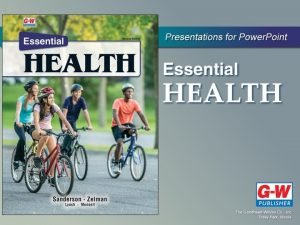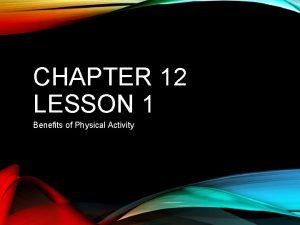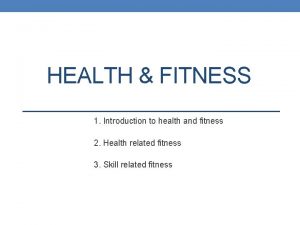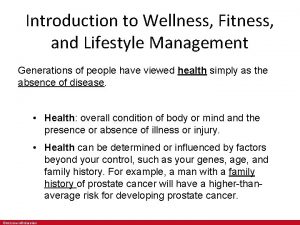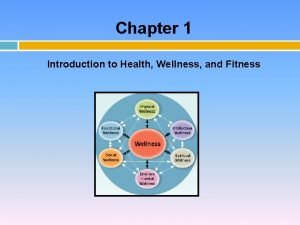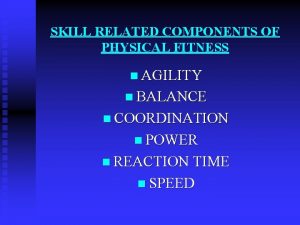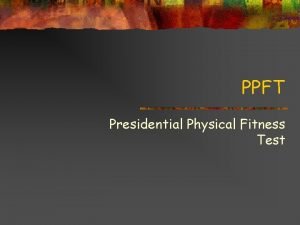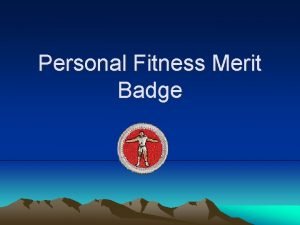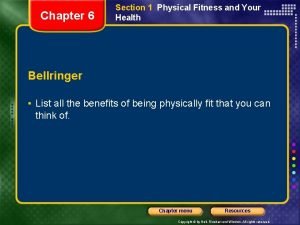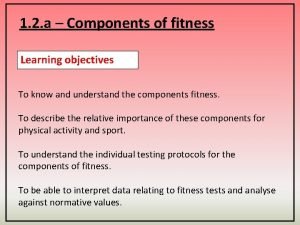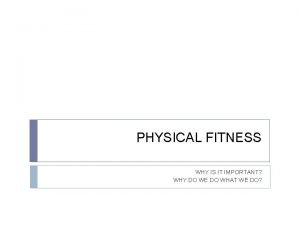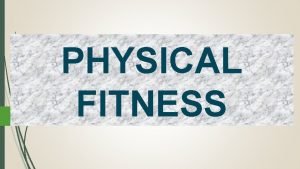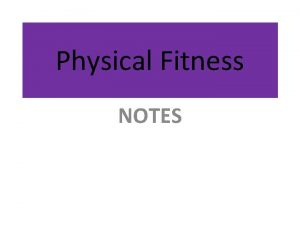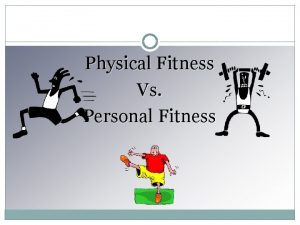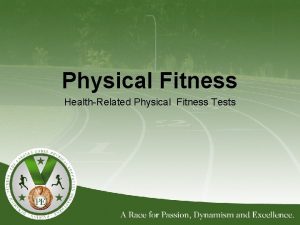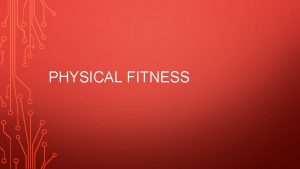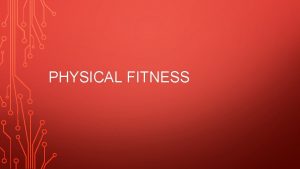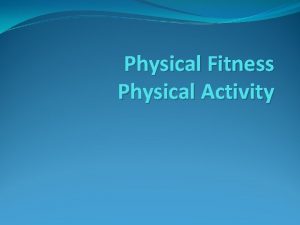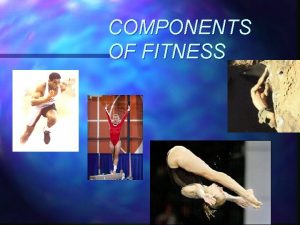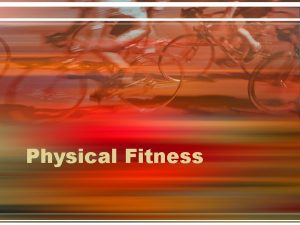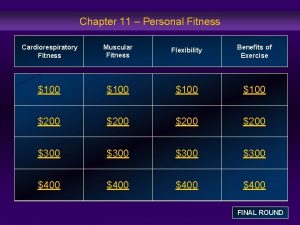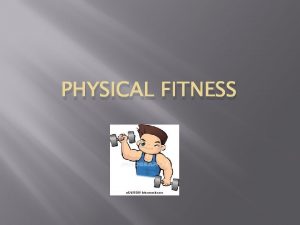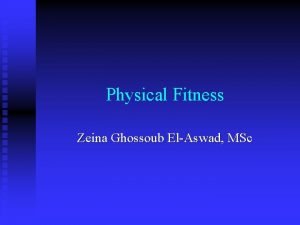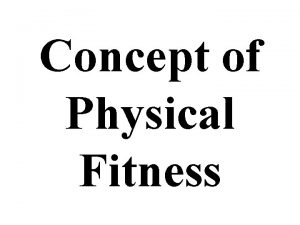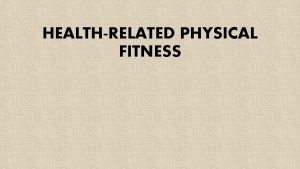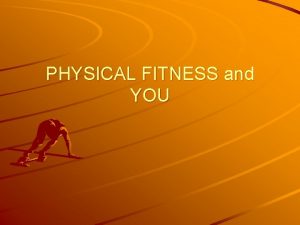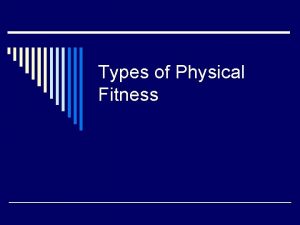Introduction Chapter 1 What is Physical Fitness Physical



















- Slides: 19

Introduction Chapter 1

What is Physical Fitness? • Physical fitness is the ability to carry out daily tasks with vigor and alertness without undue fatigue and ample energy to enjoy leisure time pursuits and meet unforeseen emergencies (President: s Council on Physical Fitness and Sport)

What is Physical Fitness? • Physical fitness is the ability to perform moderate to vigorous levels of physical activity without undue fatigue and the capability of maintaining such ability throughout life (American College of Sports Medicine)

Health-Related Physical FItness • • • Cardiorespiratory Fitness Body Composition Flexibility Muscular Strength Muscular Endurance

Performance or Skill-Related Physical Fitness • • • Balance Reaction Time Coordination Agility Speed Power

Why Promote Physical Fitness? • People who are usually inactive can improve their health and well-being by becoming even moderately active on a regular basis • Physical activity need not be strenuous to achieve health benefits • Greater health benefits can be achieved by increasing the amount of physical activity A Report of the Surgeon General (1996)

Benefits of Regular Physical Activity or Exercise • • Reduces risk of dying prematurely Reduces risk of dying from heart disease Reduces risk of developing diabetes Reduces risk of colon cancer Helps control weight Reduces depression and anxiety Promotes psychological well-being

Why Measure Physical Fitness? • • • Educate individuals about current status Individualize exercise program Evaluate effectiveness of exercise program Motivation Risk stratification

Exercise vs Physical Activity • Exercise is structured, • Physical activity is any planned activities bodily movement, designed to promote or regardless of intensity, enhance overall that is not designed physical fitness specifically to enhance physical fitness.

Assessing Physical Fitness • Ease of test administration • Ease of normative data comparison • Validity and reliability of test results

Test Validity • The ability of a test to measure what it is designed to measure (ie. Accuracy). • Correlation Coefficient (r) • Standard error of estimate (SEE)

Correlation Coefficient (r) • Expresses the relationship between two variables • Correlations range from – 1. 0 to +1. 0 • Negative correlation means as one variable increases, the other decreases or vice versa. • Positive correlation means as one variable increases, the other increases or as one decreases the other decreases. • The closer the correlation is to 1. 0, the better the relationship.

Standard Error of Estimate (SEE) • All prediction tests have an SEE • SEE is based on the normal curve – There is a 67% probability that the actual value is within the predicted value ± 1 SEE. – There is a 95% probability that the actual value is within the predicted value ± 2 SEE.

SEE Example • • • HRmax = (220 -age) SEE = 10 beats/min Age = 24 years HRmax = 220 -24 HRmax = 196 • There is a 67% probability that true HRmax is 196 ± 10 or 186 – 206. • There is a 95% probability that true HRmax is ± 20 or 176 – 216. This is the 95% Confidence Interval.

Criterion-Referenced Standards vs Normative Data • Criterion-referenced standards are as set of scores that would be “desirable” to achieve based on external criteria such as health benefit. See Table 3 -1, p. 35. • Normative standards are based on past performance of similar individuals. Often uses percentile rankings. See Table 7. 3, p. 130)

Test Reliability • The ability of a test to provide consistent results if used in repeated trials on the same individual(s). • Correlation (r)



 What is physical fitness test in mapeh
What is physical fitness test in mapeh Health related skill
Health related skill Chapter 12 physical activity and fitness
Chapter 12 physical activity and fitness Chapter 6 physical fitness
Chapter 6 physical fitness Chapter 12 physical activity and fitness
Chapter 12 physical activity and fitness Ability to use voluntary muscles repeatedly without tiring.
Ability to use voluntary muscles repeatedly without tiring. Introduction to wellness and fitness
Introduction to wellness and fitness Coaching activity introduction to health and wellness
Coaching activity introduction to health and wellness Skill related fitness power
Skill related fitness power Ppft test
Ppft test Agility mapeh
Agility mapeh Personal fitness merit badge powerpoint
Personal fitness merit badge powerpoint 2 types of fitness
2 types of fitness Hexagon agility test clockwise time average
Hexagon agility test clockwise time average Fitness chapter 6
Fitness chapter 6 Stick drop test middle score
Stick drop test middle score Physical fitness
Physical fitness The ability to do strength work at an explosive pace.
The ability to do strength work at an explosive pace. Physical fitness definition
Physical fitness definition Physical fitness notes
Physical fitness notes



